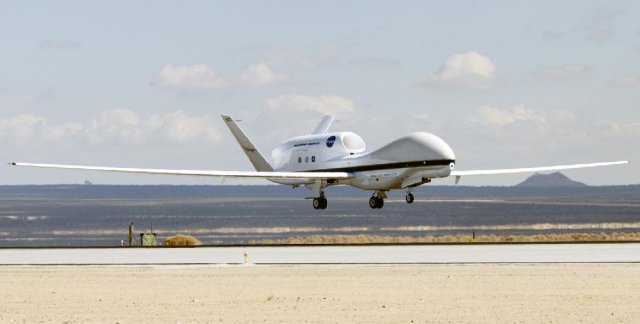 Starting this month NASA will send an autonomously flown unmanned research aircraft up to 65,000 feet over the tropical Pacific Ocean to probe unexplored regions of the upper atmosphere for answers to how Earth is changing in a warming climate.
Starting this month NASA will send an autonomously flown unmanned research aircraft up to 65,000 feet over the tropical Pacific Ocean to probe unexplored regions of the upper atmosphere for answers to how Earth is changing in a warming climate.
The first flights of the Airborne Tropical TRopopause EXperiment (ATTREX), a multi-year airborne science campaign with a heavily instrumented Global Hawk aircraft, will take off from and be operated by NASA’s Dryden Flight Research Center in Edwards, California.
Water vapor and ozone in one of the Earth’s upper atmospheric layers — the stratosphere — can have a large impact on our planet’s climate. The processes that drive the rise and fall of these compounds in the stratosphere, especially water vapor, are not well understood, which limits scientists’ ability to predict how these changes will influence global climate in the future. ATTREX will study moisture and chemical composition in the upper regions of the troposphere, the lowest region of Earth’s atmosphere, where these and other gases enter the stratosphere.
ATTREX will use the Global Hawk to carry a suite of instruments to intensively sample the tropical tropopause, the layer of the atmosphere that controls the composition of the stratosphere. Studies have shown that even small changes in stratospheric humidity may have significant climate impacts. Predictions of stratospheric humidity changes are uncertain, due to gaps in the understanding of the physical processes occurring in the tropical tropopause layer, which ranges from about 8 to 11 miles above Earth’s surface.
“The ATTREX payload will provide unprecedented measurements of the tropical tropopause layer,” said Eric Jensen, ATTREX principal investigator at NASA’s Ames Research Center in Moffett Field, Calif. “This is our first opportunity to sample the tropopause region during winter in the Northern Hemisphere when the region is coldest and extremely dry air enters the stratosphere.”
Led by Jensen and project manager Dave Jordan, also from NASA Ames, ATTREX scientists integrated 11 instruments in one of NASA’s Global Hawk aircraft. The instruments include remote sensors for measuring clouds, trace gases and temperatures above and below the aircraft, and instruments to measure water vapor, cloud properties, meteorological conditions, radiation fields, and numerous trace gases around the aircraft.
Six science flights are planned between Jan. 16 through March 15 near the equator and off the coast of Central America. In November 2011, engineering test flights ensured the instruments’ functionality and the aircraft’s ability to operate at the very cold temperatures encountered at high altitudes in the tropics, which can reach -115 Fahrenheit. The remotely piloted Global Hawk, which is capable of 24 to 30 hours of flight, is operated and managed by Dryden Flight Research Center.
The ATTREX team consists of investigators from NASA (including Ames and Langley research centers, Goddard Space Flight Center, and the Jet Propulsion Laboratory), the National Oceanic and Atmospheric Administration (NOAA), the National Center for Atmospheric Research, universities and private industry.
The science team is planning remote deployments to Guam and Australia in 2014. Scientists hope to use the acquired data to improve global model predictions of stratospheric humidity and composition.
ATTREX is a competitively selected project, one of the first investigations in NASA’s new Venture-class series of low-to-moderate cost projects. The Earth Venture missions are part of NASA’s Earth System Science Pathfinder program. These small, targeted science investigations complement NASA’s larger science research satellite missions.
The ATTREX mission will be featured during a NASA Airborne Science Mission media day on Jan. 25 at NASA Dryden that will also feature several other active science missions. Reporters interested in attending should submit requests for credentials via email to NASA Dryden’s public affairs office at DrydenPAO@nasa.gov or call 661-276-3449 by Jan. 11. Media representatives wishing to participate must be U.S. citizens or permanent resident aliens on assignment from a verifiable media organization. No substitutions of non-credentialed personnel will be allowed.
Source: NASA
